Not “Tanks” as one - we miss with benefit in DIY style

Nostalgic picture taken from Pikabu
Any thrifty admin in the distant bins sooner or later accumulate a mass of irreplaceable and valuable things. That is, a mountain of decommissioned iron, which is a pity to dispose of. There certainly is something working there, but most of this kind of good just takes place.
In this article I want to talk about some useful applications of computer junk, which can be implemented with your own hands . The condenser pendants will be left to the romantic persons, and we will consider more technical ideas.
If the candidate for "organs" can still be repaired and he is at least not from the Pentium century, then it is better to use such a server as a test site or just to sell . If iron is only suitable for use as a weight (the country needs strong programmers), then it can certainly be partially used in “crazy hands”.
One of the methods of getting rid of rubbish recommends categorizing all the good, and then evaluating with a critical eye the possible benefits of each.
From the old computer components you can collect the following list:
Hard drives and other drives;
Enclosures and printed circuit boards;
Keyboards, mice, printers;
- Power supplies and UPS, resistors, LEDs, transformers, etc.
Let's try to do something with all this.
Hard drive second life
Perhaps one of the most interesting things for crafts: there is a mirror surface, good magnets and a body, a motor. The most curious ideas are connected with the motor.
Grinding wheel
One of the simplest products from the hard disk, which is useful for processing small parts and tools.
I must say that the motor does not have a special power - the rotating disk can, if desired, be stopped with a finger. But to work with a relatively soft metal is quite suitable.
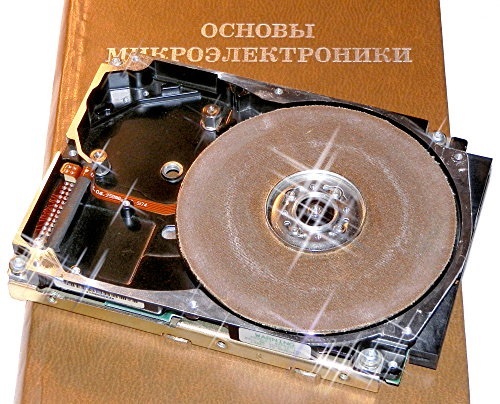
With the help of such a device, I personally sharpened several Chinese screwdrivers, an awl and a pair of knives from crimping pliers. Instead of a granular surface, you can also use felt - for example, for polishing a teaspoon darkened by coffee.
For work you will need:
Retired hard drive;
Sandpaper;
- The controller for rotation of the motor.
We open the hard drive, leaving the controller board;
Break out the read head;
- Sandpaper paste on the work surface, at the same time using a regular mount "pancakes".
If you simply apply power to a modern disk, it will work for a few seconds and stop, because the controller cannot read service information from the tracks. Powering the motor bypassing the controller is also insufficient, since the HDD uses a three-phase motor — a controller is needed for constant rotation.
There are two options:
You can use the disk controller, giving a regular start command using special utilities like Victoria HDD . But a grinding wheel constantly connected to a computer is somewhat strange;
- Make a separate controller. To control the HDD motor, a simple IC is enough. The most popular model is LB11880 , which is used in old tape recorders.
You can use other chips: TDA5140, TDA5141, TDA5142, TDA5144, TDA5145.
The general scheme will be as follows:

The scheme is taken from the site http://electronics-and-mechanics.azm.su
With all the nuances and details can be found in the article on the connection of three-phase motors . With the help of the control chip, you can accelerate any motor with a rotational speed of 7200 revolutions up to 15,000.
Clock
Most often from the case of the hard disk make the clock. Simply twisting the insides of an old alarm clock is not difficult , but the designs of a binary clock or clock based on the stroboscopic effect look more interesting.

Known project HddClock. The disk rotates a column of LEDs, creating the illusion of soaring numbers
For the manufacture of the latter is very useful HDD motor. On the surface of the disk rotates a set of LEDs that flash with a certain frequency and form symbols. Thus you can display any information, not just time.
An alternative and more brutal analogue of HddClock is the Strobeshnik project, where the numbers are cut directly on the surface of the disk:
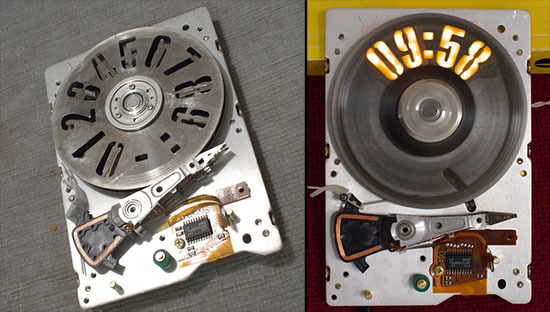
For both options you will need:
HDD;
The controller for rotation of the motor;
Light sources - LEDs (individual or in the form of a tape);
- Control Chip.
You can rotate the disk with a simple controller, like the grinding wheel, but it is more convenient to combine it with the control chip. This can be done using Arduino or AT89C52 microcontroller from old CMCs.
A complete description and production schemes can be found on the project sites:
The same scheme can be displayed on the coolers. There are even ready-made solutions, for example Thermaltake iFlash .
Light at the end of the tunnel
LEDs from servers and network devices are generally a gift for a self-made product. For example, using a motor can get a beautiful night light . Even easier to make a static lamp.
Lamp
I observed the manufacture of the next device with my own eyes. In the framework of procrastination, our employee decided to make a lamp combined with a USB hub in the form of a combat robot. It was necessary to highlight the workplace, to sit quietly at the computer at night.
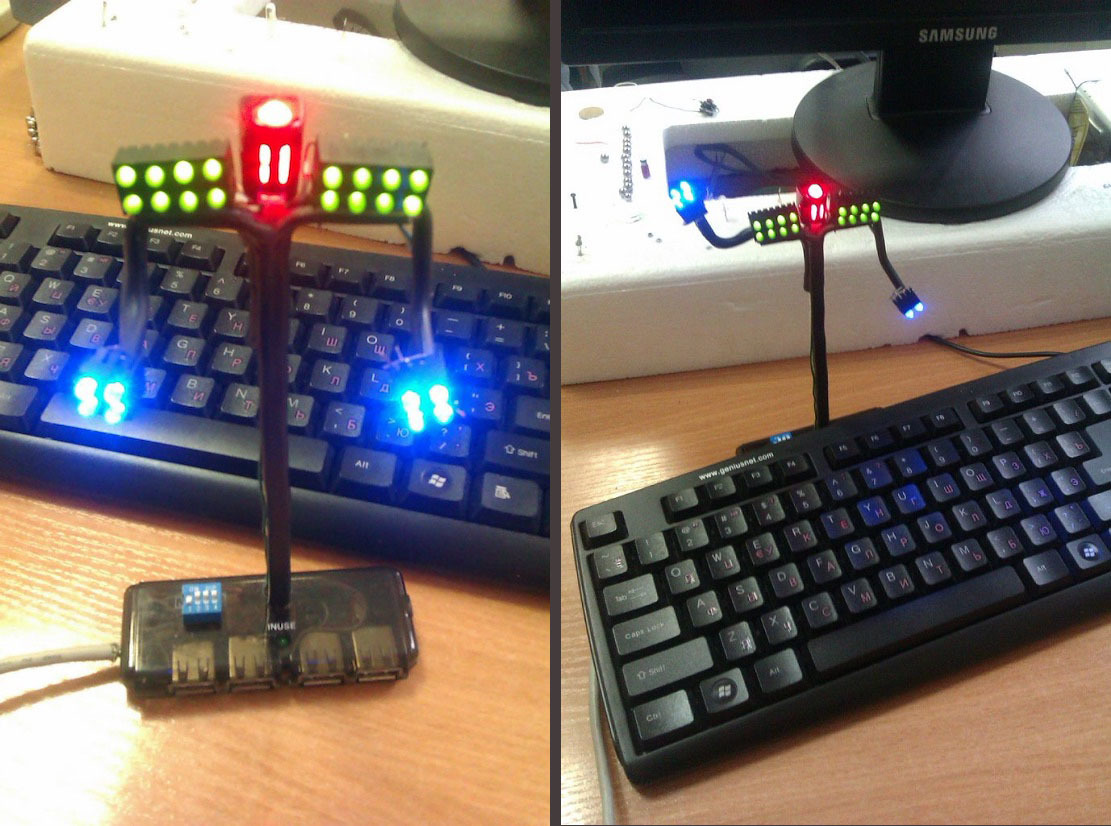
The hub and the three light sections are powered independently and controlled by a block of four switches.
To create a lamp used improvised trash:
USB hub with a broken cord;
Old mouse, from which they took the USB-cable and LED;
Idle switch;
A block of four switches from the old motherboard;
Thick copper wire;
- A piece of foam, twisted pair and a lighter.
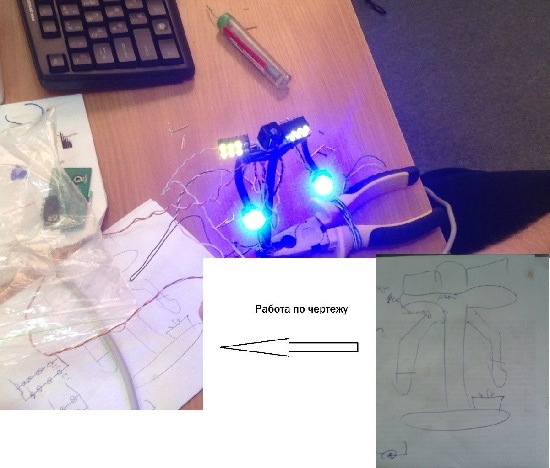
Bicycle turn indicator
If you like to ride a bike at night, then instead of your hands, you can report a turn using a special pointer. But buying it on AliExpress is unsportsmanlike, so we will make it on our own.

The image is taken from http://usamodelkina.ru
For the assembly will require:
Two shells: for the pointer and for the steering unit with switching;
Mounts for them. Clamps or straps with velcro;
LEDs are yellow or orange. RGB-diodes from the diagnostic panels of servers will also be suitable;
Power supply - depending on the number of LEDs, a 4.5 V or 9 V battery will do;
Three-position switch;
- Wires, resistors as needed.
The power source is located in the body of the steering switch:
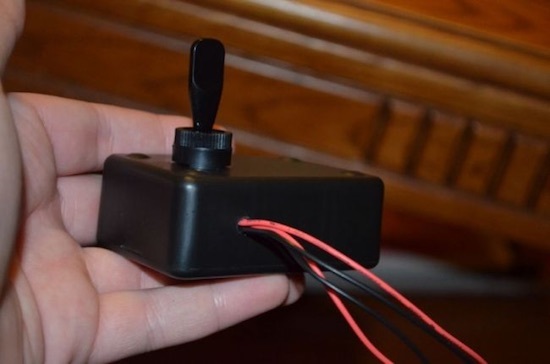
Diode groups of the second case are connected to the power leads from the switch.
Details of the manufacturing process is described in the article of the author .
If you add a transistor and a capacitor to the circuit, you can get flashing turning lights .
By the way, a very bright red LED is in the optical mouse.
Uninterruptible Power Supply Units
A conventional UPS without a SMART is pretty simple: it’s a battery and a step-up transformer in a separate box. Both elements can be successfully launched.
Torch
From the old battery can be made not only brass knuckles or a sinker for fishing (there is lead inside), but also an autonomous lamp.

With this simple fixture it is convenient to work in the garage or wait black out.
We will need:
Old UPS battery;
- 12 V light source (halogen lamp or LED).
If you assemble a flashlight on a 12 V halogen lamp, the device will be extremely simple - you can even do without a soldering iron.

On a "live" battery with a 35-watt light bulb, the luminaire will work for about two hours.
You can extend the work with the help of LEDs, for which you also need a driver. But you can simply buy an assembled ready-made LED light bulb with a modern, bright COB diode. In the servers you will not meet them, but the cost of most models on AliExpress does not exceed a couple of hundred rubles.
Car inverter
As is known, uninterruptible power supply units take 12 V from the battery and give 220 V to the computer. A similar combination is used in car inverters to charge a laptop or power a portable soldering iron.

We will need:
Written off, but working UPS without battery;
Cigarette lighter adapter;
Ordinary outlet;
- Additionally - cooler and radiator.
We unsolder the wires from the UPS sockets and install an ordinary 220 V household outlet. You can choose a variant with a lid for more aesthetics and protection against dust.
Battery leads to the cigarette lighter:
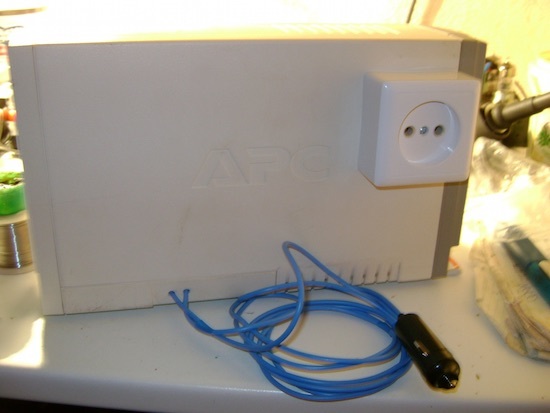
Since the UPS components are not designed for continuous operation, cooling should be provided. In addition, it is better to immediately remove the piezo-speaker so as not to irritate with a squeak. Read more in the author's blog .
It is quite difficult to assemble something tech from enclosures and printed circuit boards, because modern boards consist of many layers and are unsuitable for DIY projects. However, it is possible to collect individual radio elements from motherboards or to extract some gold , but more often they are used as decoration elements.
Optical drives remained behind the scenes, of which only various souvenirs are made. If you know something useful that can come from an old laser emitter or motor - tell us in the comments.
')
Source: https://habr.com/ru/post/315368/
All Articles